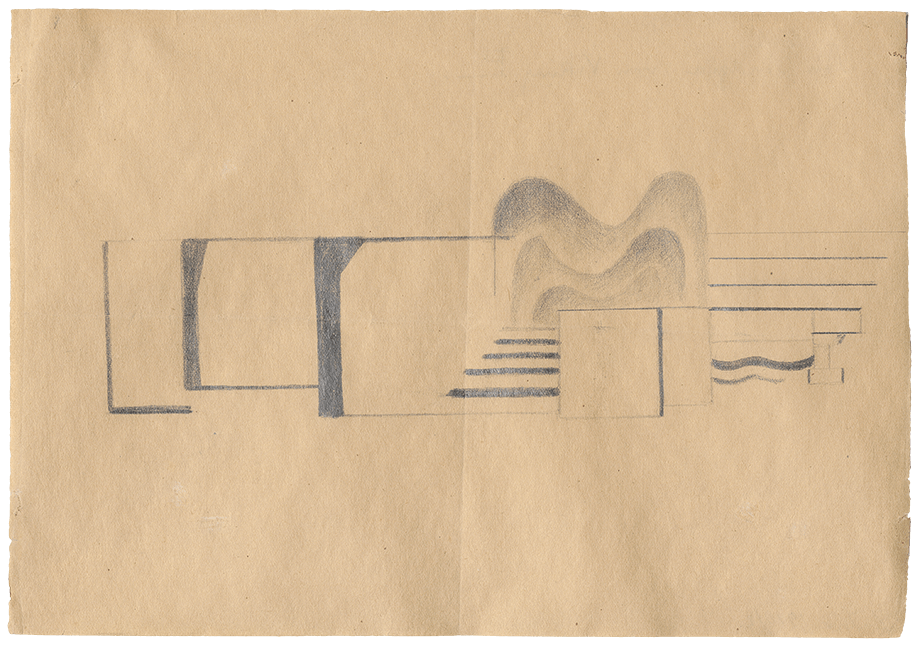When Viking Eggeling came to Zurich in 1917, he was already familiar with Switzerland. The Swedish artist had visited Ascona and Geneva, and a decade before he had worked as an art and skating teacher in the Lyceum Alpinum Zuoz near St. Moritz. Yet he was to teach the world of art more far-reaching lessons with his bold abstractions in the Dada years. That Eggeling approached the circle of Dadaists only hesitantly was probably due to his serious, rather melancholy nature and the great age difference between him and such youngsters as Tristan Tzara and Marcel Janco. Tzara and not Hans Arp, whom he knew from his days in Paris, introduced him to the artist Hans Richter in 1918. “I met a stocky man of medium height with an aquiline nose and electric blue Viking eyes. Eggeling showed me a drawing. It was as if someone had opened the Sybilline Books for me. I ‘knew’ right away what it was about” (Richter). Like Richter, Eggeling developed his work based on music. While Richter relied on the counterpoint principle rather, Eggeling dedicated himself especially to the orchestration and rhythmization of the line. This “musicalization of painting” is also reflected in his drawings’ titles and specifications. The collaboration between Eggeling and Richter was close and intensified in Klein Kölzig near Berlin from 1919 on, where the two artists stayed with Richter’s parents. It was only a short way from their “roll pictures” showing geometric shapes following each other as in time to the moving image of film. Eggeling’s drawings anticipate his film Symphonie diagonale (1923). Richter had already realized his first abstract film Rhythmus 21 before. No bible of modernism omits the two protagonists of “absolute film.” Both Buch Neuer Künstler (1922) and Die Kunstismen (1925) feature them prominently side by side.
“Le plus grand peintre suédois” (the greatest Swedish painter), as Francis Picabia presented Eggeling in his Zurich edition of 391, became only known by name during the last Zurich Dada season in 1919. He, again together with Richter, was one of those signing the manifesto of the “Radikale Künstler / artistes radicaux” (Radical Artists) and got involved in their magazine Zürich 1919, which had only reached galley-proof stage. Whereas he received a lot of acclaim for his landscapes exhibited at the Kunstsalon Wolfsberg, his abstract drawings left their viewers baffled, since “their true value could only be recognized by those initiated into the artist’s intentions and theories . . .” (Züricher Post). His drawings such as Komposition (Basse générale de la peinture. Extension) were also published in Dada 4–5 and in the magazine Der Zeltweg. These illustrations emphasize to what high degree abstract artists were an integral part of Dada Zurich. Tzara, who held several lectures on abstract art, coined the formula “Dada est l’enseigne de l’abstraction” (Dada is the signboard of abstraction) for this relationship. Eggeling also held a short lecture on abstract art (Über abstrakte Kunst) as part of the program of the eighth and final Dada soirée in the Kaufleuten Hall. It was with good reason that the lecture was scheduled to start off the manifold programme, which is said to have found a tumultuous ending.
Provenance: Donation from Prof. Dr. Alexander Weilenmann, Pittsburgh, 1970. According to his own statement, Richter was given the drawing by Viking Eggeling as a present in 1918 when they met each other for the first time in Zurich; subsequently, the work seems to have come into the possession of Tristan Tzara via Hans Arp (Richter, Dada—Kunst und Antikunst, 1964).
First exhibitions: Munich, Kunsthalle der Hypo-Kulturstiftung, Hanover, Sprengel Museum, Dada. Eine internationale Bewegung 1916–1925, 1993; Zurich, Kunsthaus, Dada global, 1994.
→ Hans Richter, Dada-Kopf [Dada Head], Z.Inv. 1977/64
→ Hans Richter, Kaiser Wilhelm als Befehlshaber des Todes [Emperor Wilhelm as the Commander of Death], Z.Inv. 1977/44
→ Hans Richter, poster design for the 1st Dada Exhibition at the Galerie Corray, DADA V:80


